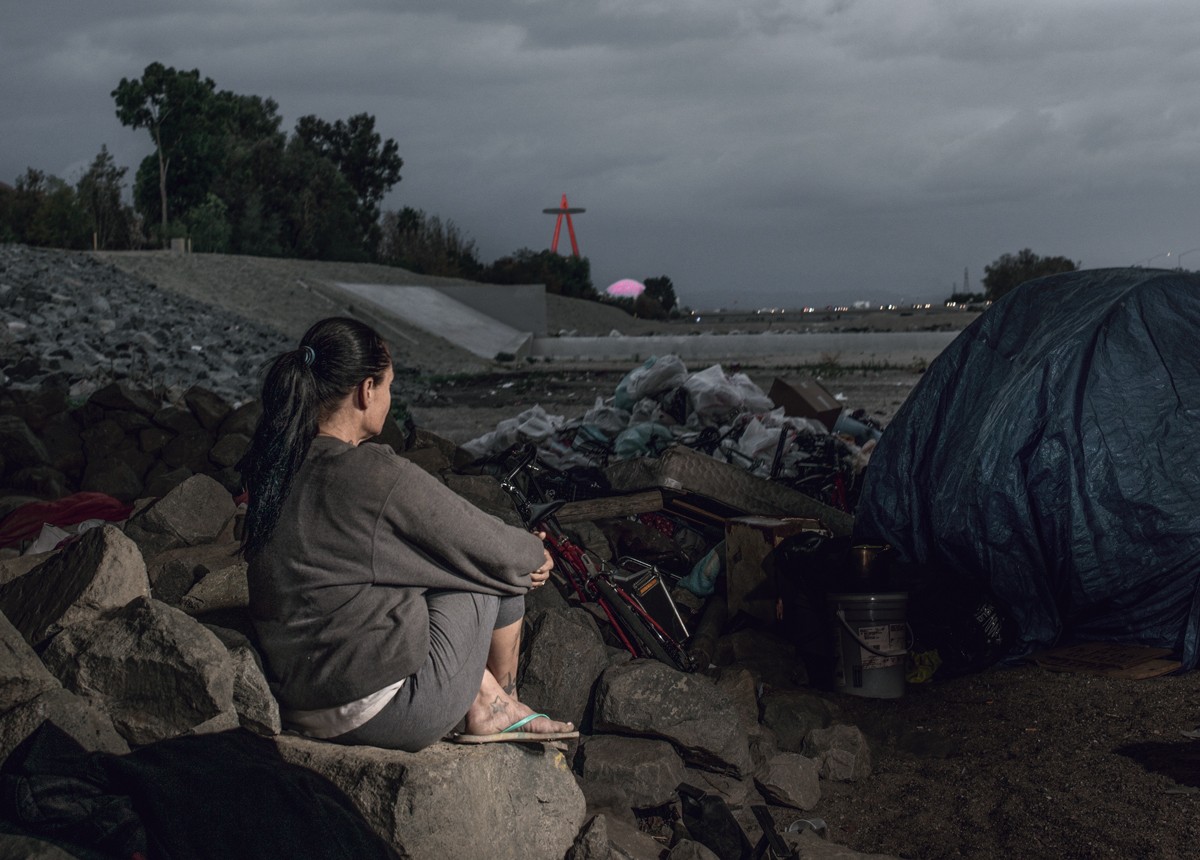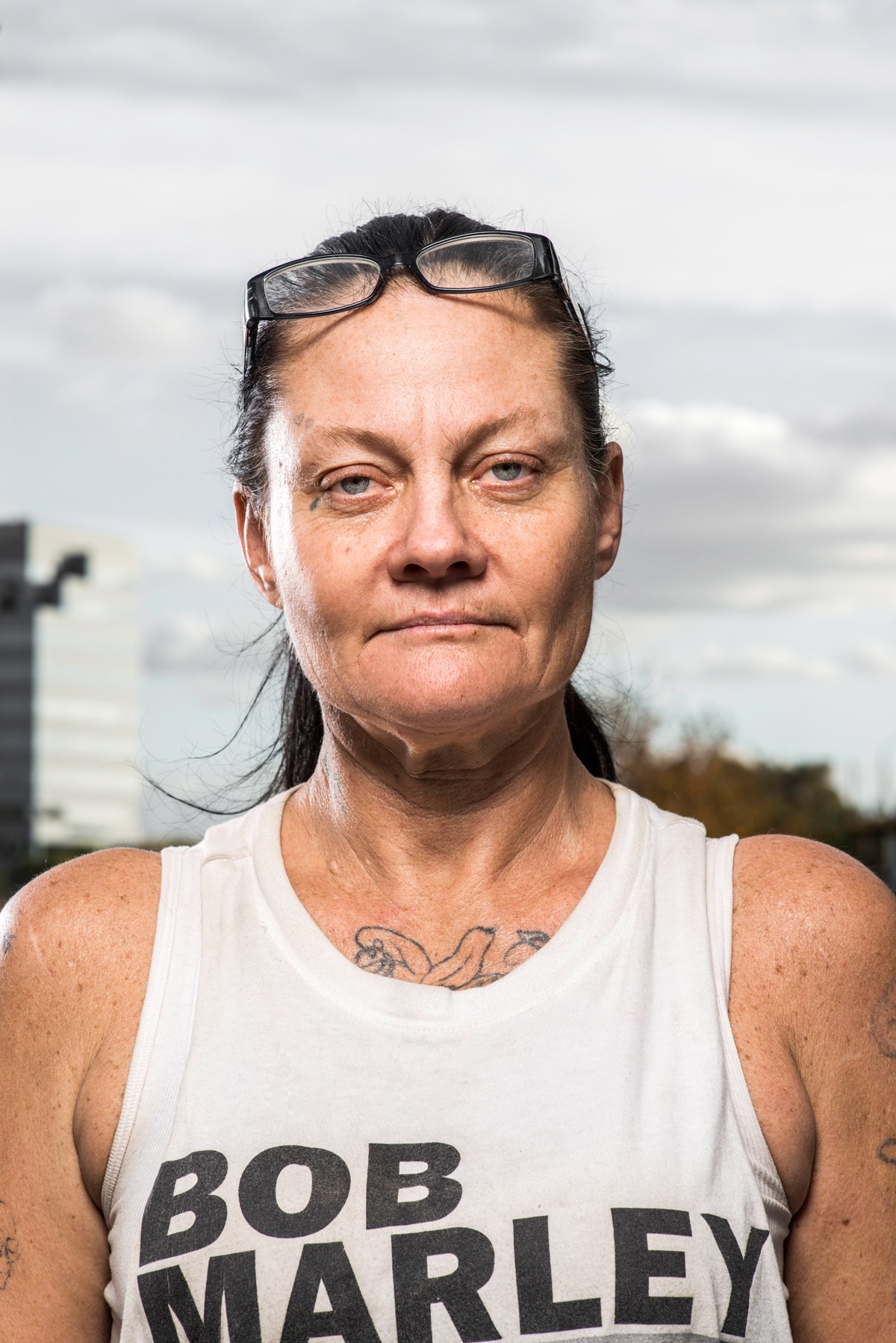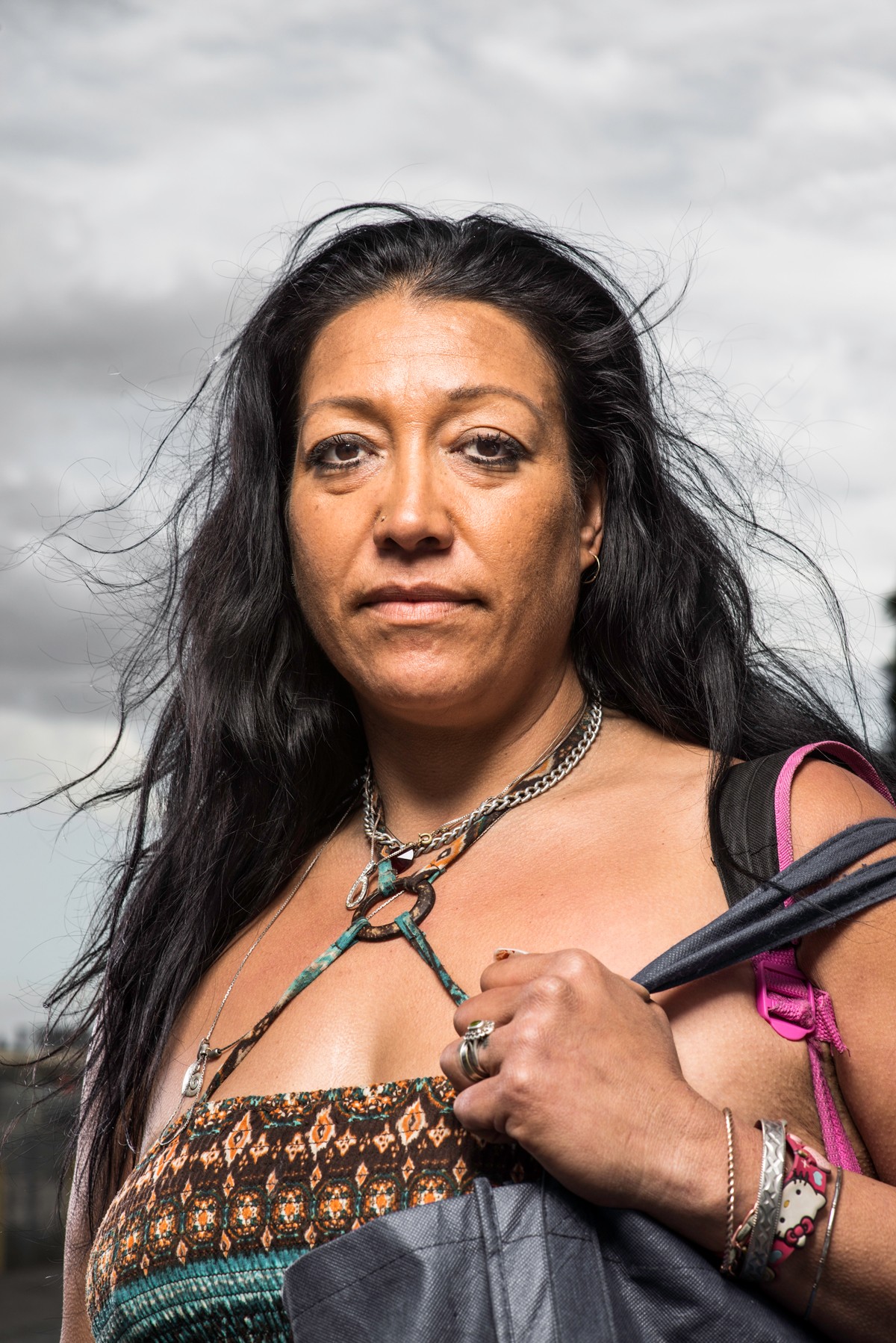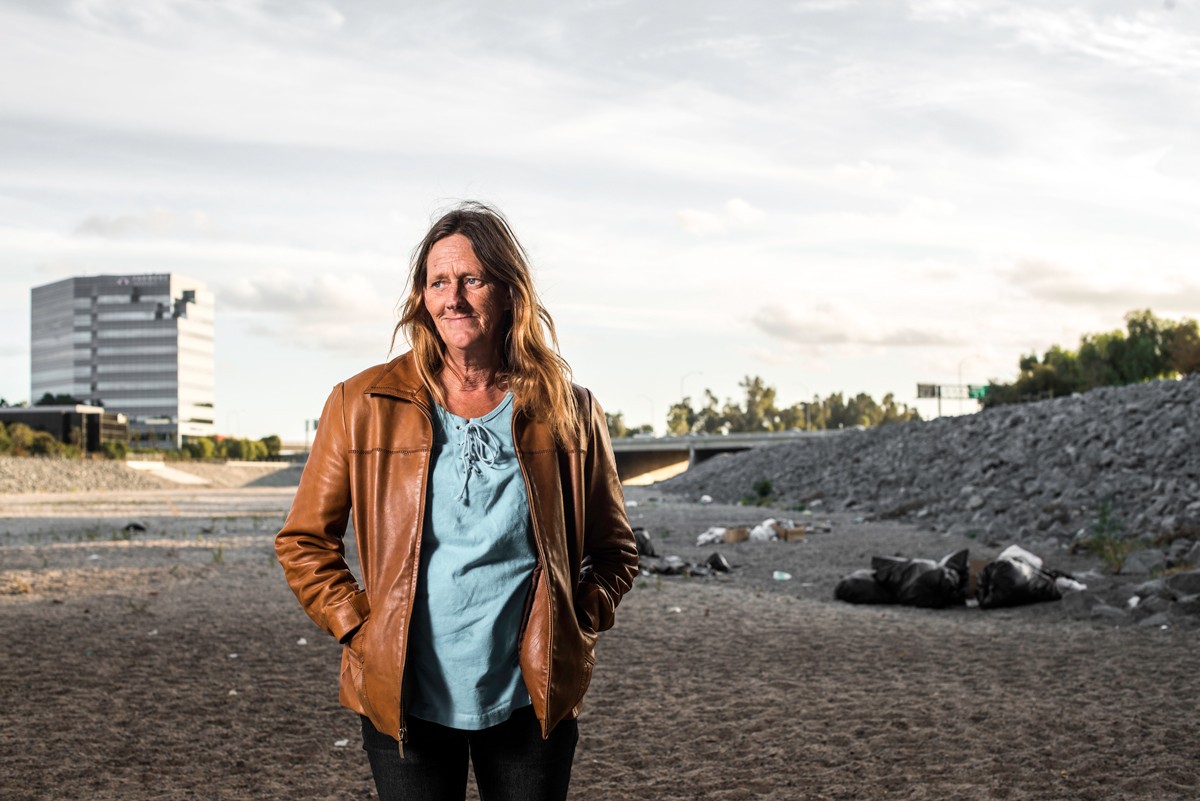
“I'm not going anywhere,” says Spice, a 50-year-old woman who lives in the Santa Ana riverbed under the Chapman Avenue overpass, regarding reports of El Niño. “This is my home.”
The mother of eight was born in Westminster and now lives in an encampment with 30 other people. Though the tent town is noticeable from the 5 freeway, it is hard to catch when you're walking along the river trail—at least until you are in front of it. For the most part, the transients keep quiet. Many, if not all of them, come to the riverbed with one intention: to be out of sight, out of mind.
Be homeless anywhere else in Orange County, and you will be stopped by the police more frequently, asked to move around, deprived of your possessions, and ticketed for hundreds of dollars for sleeping and camping in certain areas. From the Santa Ana riverbed, the red A-shaped structure of the Angel Stadium is visible, as is the night sky, filled with Disneyland fireworks. Cyclists are often rushing past. You wouldn't guess there are 440 homeless individuals living along the 30-mile trail stretching from Huntington Beach to the border of Orange and Riverside counties. Encampments are formed beneath overpasses throughout the trail and have become their own communities. Among them are mothers, fathers, people who've been laid off from their jobs, mechanics, welders, art-lovers, and even someone named Robert who can do a 14-mile wheelie on his bike.
“It's like a real close family here,” says Spice. While some individuals have been living in the riverbed for a couple of months, others have been here for 15 to 20 years.
Spice has been living in the dry, empty riverbed for a year and a half. Like some of the other transients, mishaps in her personal life are what led her here. When she and the father of her children separated, she started using drugs and subsequently spent time in jail. She stayed at La Palma Central Park for a couple of months until the cops came and gave the homeless three days to leave. Before she came to the riverbed, a former companion tried to set her on fire.
After losing her job at an optometrist's office in Santa Fe Springs, Tammy, another resident of the encampment, came to Orange County to visit her newborn nephew. She camped out in Anaheim and remembers the police confiscating her things three different times. “The last time the police took my things, I was getting food,” she says. “They just pulled up and took them. They didn't care. The police don't have a warrant for me or anything, but I still get up and run!”
Depression and drugs came hand in hand and led Tammy—along with her mother, brother and a nephew who was later taken by Child Protective Services—to the riverbed. “That's why I'm here,” says Tammy. “But I need to get surgery, so I'm trying my hardest to get back on my feet.”
Kim Lemon also came to the riverbed to avoid pressure from the police. “The cops chased me away from my encampment on Harbor Boulevard and Katella Avenue,” she says. “I was with my son then. He's not with me here.” Unlike the riverbed's many longtime residents, Lemon—who has been homeless four years—has been living here for only a few months.
Because the riverbed here is under the jurisdiction of the county and not the city of Orange, there is no crime for sleeping or camping there. However, there is a county-issued misdemeanor that prohibits camping without permission. The residents say that, for the most part, enforcement is lenient at best.
“There are cops telling us we can't be here, but they're not telling us to actually go,” Tammy explains. “'No Camping' signs have been here for a long time. But, for us, this is really the last place to go to.”
According to both Lieutenant Fred Lopez of the Orange Police Department (OPD) and the transients, cops only come if they receive complaints from passersby or are searching for someone. On a regular day, cops will drive through, take a look and leave with their sirens temporarily on.
But there are also days when they're harder on homeless people. Martha, a Santa Ana-born woman who has been living in the riverbed for the past six years, says the police have stopped the homeless when they are just sitting down. “I would prefer if they stopped me when I'm out walking in the streets and doing something than when I'm not doing anything at all,” she says.
“Sometimes, they stop you for petty little things, too, like holding a sign on the freeway—a $500 bail,” Spice adds.
[
“These are easy arrests,” Martha says. “It depends on the cop. Some are tougher on us than others.”
In mid-November, the residents say they were handcuffed below the Katella Avenue overpass right before the Avengers Half Marathon Weekend, which used the Santa Ana river trail. They were eventually let go.
* * * * *

Life on the riverbed requires loyalty and trust within the homeless population. Recently, two dramatic events occurred: a woman's son passed away, and a pregnant woman wasn't sure if she should keep her unborn baby. In both instances, Spice says, community members were there to console and give advice.
“It stresses me out sometimes, but I have to be there for them,” she explains. “It keeps us from doing nothing.”
The homeless also care for one another by feeding one another. Spice, Martha and Tammy all have caretaker roles in their communities, in which each buys groceries, cooks and picks up after their neighbors.
“The women carry the weight around here,” Martha says one afternoon, grinning.
“They really do! The men are mostly chilling on their bikes,” says Spice. “If you're with us and I've got a plate of food, I'm going to give you a plate of food.”
“When people come out of jail for stupid tickets, we'll usually have extra blankets and tents for them, too,” Martha adds. “And I'll often get food and feed everyone.”
“Yeah, Martha's got the love seat and kitchen area in her tent like mine,” Spice says, laughing. “She got a big ol' stove!”
“I do like my kitchen,” jokes Martha.
* * * * *
One way the riverbed dwellers provide for themselves is by collecting and recycling cans. Some beg on the streets. But others prefer to use their creativity. Eric draws graffiti-style signs and sells them. Spice peddles bandanas she draws on and frames decorated with chains, shells and yarn. She also painted a handicapped man's house once. Martha refurbishes furniture for people and recently got a job laying grass for a local lawn-care business.
But the infrequency and low pay of such jobs can't get them out of the riverbed. “Some days, it's good, and some days, it's not,” says Tammy. “Sometimes, people from the county will come and give us food and clothing, which we really appreciate, but what we need are jobs.”
“We feel like we are stuck,” explains Spice. “And we are. I'm scared to death to go out there and look for a job, but I got to do something. For us, it's just hard to go looking for a job when you just got done bathing in the bathroom sink at Burger King. Just saying 'hey' could be a foot in the door for us. For me, if anyone is willing to help me out, I'm ready to go!”
Getting the homeless out of the riverbed is a frequent topic of public comments at nearby city halls and meetings held by Not In My Back Yard (NIMBY) neighborhood groups such as BetterSolutions4Anaheim. Safety concerns and decreasing property values are two of the main reasons community members don't want the homeless near them. At a forum the Board of Supervisors held to discuss purchasing 1000 N. Kraemer Place in Anaheim as a potential location for the county's first permanent year-round homeless shelter, one woman angrily argued that the police did nothing when she called about the riverbed encampments.
The homeless in the riverbed know all about these complaints. “If people would just come down and talk to us, they would see we are just the same as them,” asserts Spice, her voice breaking and eyes watery. “We have four walls, too. We have friends and family. Some people with jobs go home and walk right past their kids, saying they don't have the time. Who is to say one group is better than the other? Some of us just want help.”
River dwellers have much more immediate concerns than challenging the convictions of upset residents. To get to the riverbed grounds from the bike trail, where many of the dwellers' tents are, they must climb over cantaloupe-sized rocks that are stacked on top of one another. When the weather gets too cold or too hot, they are the first ones to feel it. Sometimes, there are coyotes. In the time Spice has lived in the riverbed, she has seen three people die there, including a friend of hers named Mike.
[
“He had a bad case of pneumonia and nobody even knew it,” Spice explains. “He was already depressed, too. Another person I knew just dropped to the floor—just like that.” She snaps her fingers to demonstrate. “I don't want to see people die here anymore. I don't.”
In 2012, the riverbed homeless also faced a serial killer who seemed to be targeting its men. Itzcoatl “Izzy” Ocampo killed four homeless men, including Lloyd Middaugh, who was sleeping at the time. Ocampo committed suicide in jail before his trial by swallowing cleaning products.
* * * * *

While some residents' tents are in the riverbed itself, Spice's is on a hillside, on the corner of the overpass next to the bike trail. In early November, she and a few other residents moved their things there in preparation for El Niño. To make the hillside more livable, the residents have removed layers of rocks to create a pathway going up—almost like a staircase—and smooth flooring for their tents. The hillside is lined with tents, tarps, bikes, trash cans and blankets. During the first week of November, there was slight rain, but it only left a large puddle in the riverbed. Since then, nights in Orange have dropped to around 40 degrees Fahrenheit, and the homeless are feeling it.
“When it rains, I go to my area on top of the hill, and everyone else would be all in the water,” says Spice. As time passes, she's been stocking up on water, canned foods and batteries for flashlights in case it rains harder.
Escaping the gush of water that may come because of El Niño is tougher for people like Tammy, however, whose tent is on the riverbed grounds. “If they open the floodgates, we're screwed,” she says. “The last time it rained, they opened them, and all of us down here gathered together—no fighting, no arguing, no nothing—and we ran up the hill. Thankfully, we made it out on time, but we were all soaking wet.”
Spice is confident the county will do something if the weather gets bad. “If they hear something has happened here, they will come by,” she says. “They will see if there are no heads in the water.”
On Nov. 12, as Spice anticipated, the county took action. Orange County Public Works (OCPW) and the OPD told the riverbed dwellers to take their belongings and find another place to stay. The OCPW was doing one of its regular sweeps to clear out the county's flood channels and told the Weekly it'll be doing more once El Niño hits.
Eve Garrow, homeless-policy analyst of the American Civil Liberties Union of Southern California, came out to document the sweeps. “People were pulling their personal property—tents, all of their belongings—up off the embankment onto areas they felt were off-limits for the county or the police department,” Garrow says. However, because they consider the riverbed home, the homeless returned soon after and went back to their normal lives.
Along with a network of disaster-response organizations, Collaborative Organizations Active in Disasters, the county is also developing emergency plans for disaster victims, including homeless individuals, should El Niño prevail. “When homeless populations are willing and resources are available, riverbed homeless and other homeless individuals will be connected to shelter and housing resources,” explains county public-information manager Jean Pasco.
However, some people believe the county is conducting these sweeps for other reasons. Tim Houchen, a formerly homeless man who now runs the aid organization Hope 4 Restoration, was also there to document the sweeps. “The county is telling the homeless at the riverbed that they have to leave it for safety reasons, which may be true, but they also just want them to be gone,” he says. “This is evident to many of us who regularly attended city council meetings and forums this past year; so many people complained about the homeless in the riverbed. Within the next few months, I feel like the homeless there will be an even bigger topic at city council meetings.”
* * * * *

Many of the homeless in the riverbed are what social-service groups call “chronically homeless,” which means they have been homeless for at least a year, unemployed for a long period of time and reside in places not meant for human habitation, such as the riverbed. According to the national definition of a “chronically homeless” person by the United States Interagency Council on Homelessness, these individuals are heavily reliant on social services and emergency health care and tend to have at least one diagnosable disorder (though most have multiple, complex disorders). The combination of these factors is what prevents them from attaining long-term employment and housing.
[
In the early 2000s, one solution for chronic homelessness—permanent, supportive housing—became nationally recognized, and the conversation about homelessness shifted from managing homelessness to ending it completely. This solution pairs subsidized housing with services such as counseling, health screenings and employment navigation. The end-goal is to stabilize chronically homeless individuals and reintegrate them into society.
This past November, Orange County became closer to implementing this solution by unanimously approving the purchase of 1000 N. Kraemer Place in Anaheim for a permanent year-round homeless shelter. This joint shelter/multi-service center will serve up to 200 individuals who can only enter after passing a screening and securing a bed reservation. In previous years, the county's efforts in Santa Ana and Fullerton to open up such a shelter failed—primarily because of NIMBY pressure.
To Larry Haynes, the executive director of Mercy House—a nonprofit organization that provides aid to the homeless—this purchase was historical. “First of all, there is compassion as to why we should be doing this. The Orange County Armory Emergency Shelters are not an adequate response to homelessness,” says Haynes, who has been working on homelessness issues for the past 27 years. “But now, because we have this new perspective of ending homelessness altogether, there are no longer going to be emergency shelters where people go to temporarily and just feel bad. Now it's about having a platform where we will connect you to housing opportunities.
“In the early 1980s and 1990s,” he recalls, “we would talk about opening up a soup kitchen to deal with homeless. That's good, but it is not going to solve the problem. It is like just putting a Band-Aid on it. We need to lower barriers, implement rapid rehousing and figure out how to help people who are service-resistant. That is what the housing-first approach does. If people really believe in ending homelessness, we have got to take that shot.”
Haynes is one of several individuals who took that shot for Orange County. For the past six years, he attended community events and knocked on doors to talk about the possibility of ending homelessness. Later, he became a board member on Orange County's Commission to End Homelessness and helped author the county's Ten-Year Plan to End Homelessness, which compiles resources available to homeless individuals and provides oversight and accountability for implementing the county's goal.
Others who took a shot on the county's behalf, according to Haynes, are Orange County supervisors Todd Spitzer and Shawn Nelson. “At a Board of Supervisors meeting, I recall Supervisor Nelson going to great lengths about doing the right thing,” says Haynes. “Both supervisors pledged their support of the permanent year-round homeless shelter despite possibly losing their political seats. I was blown away. I have been around for a long time, and I have not seen that kind of courage in local political leadership before. Everyone seems to be on board, and that is why I'm such a big believer in this cause.”
Haynes believes that, if the Kraemer shelter goes through as the county hopes, it won't be the county's last such shelter. “In fact, we'll see a regional approach where shelters will start opening across the county,” he says. “This is the missing piece to bringing down our homeless numbers.”
Now that the county is a step closer to putting up its first permanent year-round homeless shelter, it faces a new challenge: finding housing units while avoiding bottleneck with landlords. Problems that have persisted in the past, such as restrictive funding and community opposition, also remain.
* * * * *

Come December, Spice says things have gotten better at the riverbed. She and fellow riverbed dweller Eric had just gotten engaged (though he was arrested shortly afterward), and she had a good Thanksgiving.
“I got to slow down quite a bit,” she says. “The kids came over, and I am trying to make my tent a home as much as possible now.”
Thanksgiving at Spice's started at 8 a.m. and ended at 10 p.m. “There were so many plates of food—I'm still picking them up,” she says, smiling. “It was awesome—so awesome. But we only got one thing of pumpkin pie!” After the celebration, she stopped by everyone else's tents to see how they were doing.
With the holidays around the corner, the homeless have been feeling relieved because the police have been more lenient. Instead of immediately arresting a homeless person for, say, holding a sign by the freeway, the officer will honk at them as a warning. Of course, if the officer has to honk too many times, he or she will receive a ticket.
[
One month after I met Spice, she repeated something she told me during our first encounter: “What I would ask from people is for them to come and spend time with us. Just so you can feel—not so you can feel sorry for us—but so you can see what our daily lives are like,” she says. “People would learn how difficult it is for us to find a job—how unconfident we are—and they'd see the difference in the little things, like the attitude toward us. Everything.”

